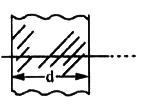A proton (mass m) accelerated by a potential difference V flies through a uniform transverse magnetic field B. The field occupies a region of space by width 'd'. If α' be the angle of deviation of proton from initial direction of motion (see figure), the value of sin a will be:

qV√pd2m
Bd√q2mV
Bd√q2mV
B2√qdmv
The correct Answer is:B
Topper's Solved these Questions
- APPENDICES ( REVISION EXERCISE )BOOK - AAKASH SERIESCHAPTER - APPENDICES ( REVISION EXERCISE )EXERCISE - REVISION EXERCISE (CUTTENT ELECTRICITY )
108 Videos
- ALTERNATING CURRENTBOOK - AAKASH SERIESCHAPTER - ALTERNATING CURRENTEXERCISE - EXERCISE - III
39 Videos
- APPENDICES (REVISION EXERCISE)BOOK - AAKASH SERIESCHAPTER - APPENDICES (REVISION EXERCISE)EXERCISE - LAW OF MOTION
91 Videos
Similar Questions
A proton (mass m) accelerated by a potential difference V flies through a uniform transverse magnetic field B. The field occupies a region of space by width d. If α be the angle of deviation of proton from initial direction of motion , the value of sin α will be
View SolutionA particle accelerated by a potential difference V flies through a uniform transverse magnetic field with induction B. The field occupies a region of space d in thickness. Prove that the angle a through which the particle deviates from the initial direction of its motion is given by.
α=sin−1(dB√q2Vm)
where m is the mass of the particle.
View Solution
Knowledge Check
A proton of mass m and charge q is accelerated by a potential difference V in a perpendicular magnetic field B occupying space t. The value of sinθ where θ is deviation of proton from initial direction is
ABt√q3VmBBt√q2VmCBt√2qVmDBt√qVmAn electron accelerated through a potential difference V passes through a uniform transverse magnetic field and experiences a force F. If the accelerating potential is increased to 2V, the electron in the same field will experience a force
AFBF/2C√2FD2FAssertion : An electron and a proton are accelerated by same potential difference and then enter in uniform transverse magnetic field. The radii of the two will be different.
Reason : Charges on them are different.AIf both Assertion and Reason are true and the Reason is correct explanation of the Assertion.BIf both Assertion and Reason are true but Reason is not the correct explanation of AssertionCIf Assertion is true, but the Reason is false.DIf Assertion is false but the Reason is true.
A particle accelerated by a potential difference V flies through a uniform transverse magnetic field with induction B. The field occupies a region of space din thickness. Prove that the angle a through which the particle deviates from the initial direction of its motion is given by.
α=sin−1(dB√q2Vm)
where m is the mass of the particle.
View SolutionA charged particle having mass m and charge q is accelerated by a potential difference V, it flies through a uniform transverse magnetic field B. The field occupies a region of space d. Fnd the time interval for which it remains inside the magnetic field.
View Solution(a) A charged particle having mass m and charge q is accelerated by a potential difference V, it flies through a uniform transverse magnetic field B. The field occupies a region of space d. Find the time interval for which it remains inside the magnetic field.
(b) An α-particle is acceleration by a potential difference of 104V. Find the change in its direction of motion if it enters normally in a region of thickness 0.1m having transverse magnetic induction of 0.1T.
(mα=6.4×10−27kg).
( c) A 10g bullet having a charge of 4μC is fired at speed of 270m/sec in a horizontal direction. A vertical magnetic field of 500μT exists in the space. Find the deflection of the bullet due to the magnetic field as it travels through 100m. Make appropriate approximations.
View SolutionA proton accelarted by a potential differnce V=500kV fieles through a unifrom transverse magnetic filed the induction B=0.54T. The field occupies a region of space d=10cm in thickness (Fig). Find the angle α through which the proton deviates from the initial direction of its motion.

View SolutionAssertion : An electron and a proton are accelerated by same potential difference and then enter in uniform transverse magnetic field. The radii of the two will be different.
Reason : Charges on them are different.
View Solution
